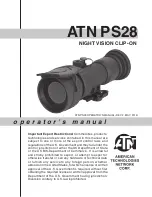
Visit us at:
nationalgeographic.com
9
How Do I Use My Microscope
Before you use your microscope, make sure that the table, desk or surface that you place it on is stable and is not
subject to vibration. If the microscope needs to be moved, hold it by the arm and base while carefully transferring it.
Once the microscope is in a suitable location and the batteries are installed, check the light source to make sure that it
illuminates. Use a microfiber cleaning cloth to gently wipe the lenses off. If the stage is dirty with dust or oil, carefully
clean it off. Make sure that you only raise and lower the stage using the focus adjustment knob.
How Do I Operate The Illumination?
Locate the mirror/light on the base of the microscope. Flip the mirror/light to the “on” position (with the light facing
up) and the light will illuminate. This microscope is equipped with an incandescent light that illuminates the specimen
from below. The colour filter wheel is located in the middle of the microscope stage. The filters help you when you
observing very bright or clear specimens. Using these filters, you can choose various brightness levels and colours.
This helps you better recognize the components of colourless or transparent objects (e.g. sea salt).
How Do I Adjust My Microscope Correctly?
Place the microscope in a suitable location as described above, and sit in a comfortable viewing position. Always start
each observation with the lowest magnification. Adjust the distance of the microscope stage so that the stage is in the
lowest position — farthest away from the turret head. Turn the objective turret until it clicks into place at the lowest
magnification (Objective: 5x/Magnification: 100x). Note: Before you change the objective setting, always make sure
the microscope stage is farthest away from the turret by rotating the focus knob. Separating the stage and turret by
rotating the focus knob will avoid causing damage to the specimen slide or microscope. When starting an observation,
always start with the 5x objective in the rotating head.
Troubleshooting Guide:
Problem
Solution
No recognizable image
Turn on light, Readjust focus,
Start with the lowest power objective (5x)
No image
Centre object on slide under
lowest power objective
No light
Replace batteries, Check on/off position
How Do I Observe The Specimen?
Sitting in your location with adequate illumination chosen from the colour filter wheel, the following basic rules should
be observed. Start with a simple observation at the lowest magnification. Position the object or specimen in the middle
of the stage under the stage clips, centreed over the lower light. Focus the image by rotating the focus knob until a
clear image appears in the eyepiece.
Place the prepared slide directly under the objective on the microscope stage and secure it
with the stage clips. The prepared slide should be located directly over the lower illumination.
Look through the eyepiece and carefully turn the focus knob until the image appears clear and
sharp. Now you can select a higher magnification by rotating to the 15x/300x objective turret.
Higher levels of magnification can be achieved by turning the objective turret to a higher
setting (300x or 900x). Following this procedure creates a steady increase of magnification
without overpowering the view of the object. The following magnification order should be used: 100x, 300x then 900x.
Each time the magnification changes (due to the objective change), the image sharpness must be readjusted with the
focus knob. When doing this, be careful because if you move the microscope stage too quickly, the objective and the
slide could come into contact and cause damage to the slide or microscope.
For transparent objects (e.g. sea salt), light is projected by the lower light traveling from below the stage, through
the objective and eyepiece, and finally into your eye. This process of light transmission is known as microscopy. Many
micro-organisms found in water, plant components and the smallest animal parts are transparent in nature. Opaque
specimens, on the other hand, will need to be prepared for viewing. Opaque specimens can be made transparent by
a process of treatment and penetration with the correct materials (media), or by slicing. You can read more about
creating specimens in the enclosed microscope experiments booklet.
Magnification Guide:
Eyepiece
Objective
Power
20x
5x
100x
20x
20x
400x
20x
45x
900x


























